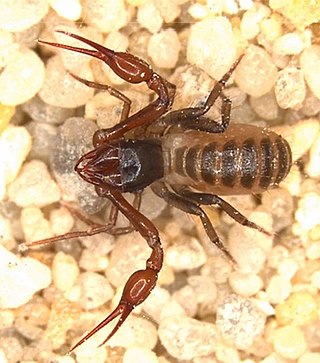
Mole Creek Karst is a national park situated in the North of Tasmania, Australia, 168 km northwest of Hobart. It is located on the slopes of the Great Western Tiers to the east of the town of Mole Creek. It is the only national park in Tasmania created specifically to protect karst landforms. It is part of the Tasmanian Wilderness World Heritage Site.

The Tooth Cave pseudoscorpion(Tartarocreagris texana) is a small cave-dwelling arachnid of the family Neobisiidae. The species was originally assigned to the genus Microcreagris, and then reassigned to Austalillocregris before arriving at its current genus, Tartarocreagris. The Tooth Cave pseudoscorpion has a small geographic distribution, known to occur in only two caves in Travis County, Texas. Additionally, it is tentatively identified in two nearby caves in Texas, but more research is necessary to accurately define the range where the species lives. There is little known about the biology, life cycle, and life history of the Tooth Cave pseudoscorpion due to a lack of research and study. Because of this, the Tooth Cave pseudoscorpion is listed on the IUCN Red List as data deficient. Under the Endangered Species Act, the Tooth Cave pseudoscorpion is listed as endangered. Recovery plans for the species focus mostly on preserving the karst ecosystem that the pseudoscorpions live in, especially including lessening human impacts on the environment.
Apozomus eberhardi is a species of short-tailed whip-scorpions, also known as schizomids, in the Hubbardiidae family. It is endemic to Australia. It was described in 2001 by Australian arachnologist Mark Harvey. The specific epithet eberhardi honours Stefan Eberhard, who collected the sole specimen.
Austrochthonius easti is a species of pseudoscorpion in the Chthoniidae family. It is endemic to Australia. It was described in 1991 by Australian arachnologist Mark Harvey. The specific epithet easti honours Malcolm East, who collected one of the specimens.
Lagynochthonius mordor is a species of pseudoscorpion in the Chthoniidae family. It is endemic to Australia. It was described in 1989 by Australian arachnologist Mark Harvey. The specific epithet mordor refers to the type locality.
Tyrannochthonius garthhumphreysi is a species of pseudoscorpion in the Chthoniidae family. It is endemic to Australia. It was described in 2008 by Australian arachnologists Karen Edward and Mark Harvey.
Tyrannochthonius butleri is a species of pseudoscorpion in the Chthoniidae family. It is endemic to Australia. It was described in 1991 by Australian arachnologist Mark Harvey. The specific epithet butleri honours naturalist Harry Butler (1930–2015), who provided funding for fieldwork in the Cape Range.
Pseudotyrannochthonius jonesi is a species of pseudoscorpion in the Pseudotyrannochthoniidae family. It is endemic to Australia. It was described in 1962 by American arachnologist Joseph Conrad Chamberlin.
Pseudotyrannochthonius tasmanicus is a species of pseudoscorpion in the Pseudotyrannochthoniidae family. It is endemic to Australia. It was described in 1970 by Australian zoologist Alan Dartnall.
Pseudotyrannochthonius typhlus is a species of pseudoscorpion in the Pseudotyrannochthoniidae family. It is endemic to Australia. It was described in 1970 by Australian zoologist Alan Dartnall.
Pseudotyrannochthonius hamiltonsmithi is a species of pseudoscorpion in the Pseudotyrannochthoniidae family. It is endemic to Australia. It was described in 1968 by Austrian arachnologist Max Beier.
Pseudotyrannochthonius gigas is a species of pseudoscorpion in the Pseudotyrannochthoniidae family. It is endemic to Australia. It was described in 1969 by Austrian arachnologist Max Beier.

Pseudotyrannochthonius giganteus is a species of pseudoscorpion in the Pseudotyrannochthoniidae family. It is endemic to Australia. It was described in 1971 by Austrian arachnologist Max Beier.
Indohya damocles is a species of pseudoscorpion in the Hyidae family. It is endemic to Australia. It was described in 2007 by arachnologists Mark Harvey and Erich Volschenk.
Indohya napierensis is a species of pseudoscorpion in the Hyidae family. It is endemic to Australia. It was described in 2007 by arachnologists Mark Harvey and Erich Volschenk.
Ideoblothrus papillon is a species of pseudoscorpion in the Syarinidae family. It is endemic to Australia. It was described in 1991 by Australian arachnologist Mark Harvey. The specific epithet papillon refers to the type locality.
Ideoblothrus woodi is a species of pseudoscorpion in the Syarinidae family. It is endemic to Australia. It was described in 1991 by Australian arachnologist Mark Harvey. The specific epithet woodi honours Ray Wood.
Ideoblothrus nesotymbus is a species of pseudoscorpion in the Syarinidae family. It is endemic to Australia. It was described in 1991 by Australian arachnologists Mark Harvey and Karen Edward. The specific epithet nesotymbus comes from Greek: nesos (‘island’) and tymbos (‘tomb’), with reference to the type locality.
Anatemnus cavernicola is a species of pseudoscorpion in the Atemnidae family. It is endemic to Australia. It was described in 1976 by Austrian arachnologist Max Beier. The specific epithet cavernicola ('cave-dwelling') refers to the species’ habitat.
Austrochernes guanophilus is a species of pseudoscorpion in the Chernetidae family. It is endemic to Australia. It was described in 1967 by Austrian arachnologist Max Beier.


